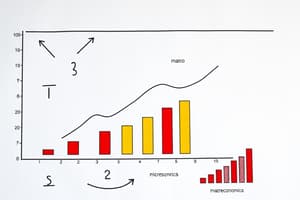Podcast
Questions and Answers
What is the primary focus of microeconomics?
What is the primary focus of microeconomics?
- Assessing international trade dynamics
- Examining individual markets and consumer behavior (correct)
- Studying the economy as a whole
- Analyzing government fiscal policies
Which of the following best defines scarcity in economics?
Which of the following best defines scarcity in economics?
- Limited resources versus unlimited wants (correct)
- Optimal allocation of resources
- Average consumption levels in a society
- Unlimited resources available to meet needs
What is the main characteristic of perfect competition?
What is the main characteristic of perfect competition?
- Few firms with differentiated products
- Fixed prices set by a government authority
- A single firm with complete market control
- Many firms with identical products (correct)
What does the Gross Domestic Product (GDP) measure?
What does the Gross Domestic Product (GDP) measure?
Which economic system is characterized by collective ownership of resources?
Which economic system is characterized by collective ownership of resources?
What is the purpose of fiscal policy?
What is the purpose of fiscal policy?
Which factor is NOT a part of macroeconomics?
Which factor is NOT a part of macroeconomics?
What does supply-side economics emphasize?
What does supply-side economics emphasize?
Flashcards are hidden until you start studying
Study Notes
Key Concepts in Economics
-
Definition of Economics
- Study of how individuals and societies allocate scarce resources.
- Focuses on decision-making regarding production, distribution, and consumption.
-
Microeconomics vs. Macroeconomics
- Microeconomics: Examines individual markets and the behavior of consumers and firms.
- Macroeconomics: Studies the economy as a whole, including inflation, unemployment, and GDP.
-
Basic Economic Principles
- Scarcity: Limited resources versus unlimited wants.
- Opportunity Cost: The next best alternative forgone when making a choice.
- Supply and Demand: Price determination in a competitive market.
- Supply: Quantity of a good available for sale.
- Demand: Quantity of a good consumers are willing to buy.
-
Market Structures
- Perfect Competition: Many firms, identical products, easy entry and exit.
- Monopolistic Competition: Many firms, differentiated products.
- Oligopoly: Few firms dominate market; interdependent pricing.
- Monopoly: Single firm controls entire market; barriers to entry.
-
Economic Indicators
- Gross Domestic Product (GDP): Total value of all goods and services produced in a country.
- Unemployment Rate: Percentage of the labor force that is jobless and seeking employment.
- Inflation Rate: Rate at which general price levels rise, eroding purchasing power.
-
Economic Systems
- Capitalism: Market-based economic system with private ownership of resources.
- Socialism: Economic system where resources are owned collectively or by the state.
- Mixed Economy: Combination of capitalism and socialism.
-
Fiscal and Monetary Policy
- Fiscal Policy: Government adjustments in spending and taxes to influence the economy.
- Monetary Policy: Central bank actions (like interest rate changes) to manage money supply.
-
International Economics
- Trade: Exchange of goods and services across borders, affected by tariffs and quotas.
- Exchange Rates: Value of one currency in relation to another, influencing trade and investments.
-
Economic Theories and Models
- Classical Economics: Belief in free markets and human self-interest driving growth.
- Keynesian Economics: Emphasis on total spending in the economy and its effects on output and inflation.
- Supply-Side Economics: Focus on boosting economic growth by increasing supply of goods and services.
-
Current Trends and Issues
- Globalization, inequality, environmental sustainability, and technological impacts on economies.
Understanding these concepts provides a foundation for analyzing economic behavior and policy.
Definition of Economics
- Economics studies resource allocation in individuals and societies.
- It focuses on decisions about production, distribution, and consumption.
Microeconomics vs. Macroeconomics
- Microeconomics analyzes individual markets, consumer, and firm behavior.
- Macroeconomics examines the entire economy, including inflation, unemployment, and GDP.
Basic Economic Principles
- Scarcity: Limited resources versus unlimited wants.
- Opportunity cost: Value of the next best alternative forgone.
- Supply and demand determine prices in competitive markets.
- Supply: Quantity of a good available for sale.
- Demand: Quantity consumers are willing to buy.
Market Structures
- Perfect competition: Numerous firms, identical products, easy entry/exit.
- Monopolistic competition: Many firms, differentiated products.
- Oligopoly: Few dominant firms, interdependent pricing.
- Monopoly: Single firm controls the market, entry barriers exist.
Economic Indicators
- GDP: Total value of goods and services produced within a country.
- Unemployment rate: Percentage of the jobless labor force actively seeking work.
- Inflation rate: Rate of increase in general price levels, reducing purchasing power.
Economic Systems
- Capitalism: Market-based system with private resource ownership.
- Socialism: Resources owned collectively or by the state.
- Mixed economy: Combines elements of capitalism and socialism.
Fiscal and Monetary Policy
- Fiscal policy: Government spending and tax adjustments to influence the economy.
- Monetary policy: Central bank actions (e.g., interest rate changes) to manage the money supply.
International Economics
- Trade: Exchange of goods and services across borders, influenced by tariffs and quotas.
- Exchange rates: Value of one currency relative to another, affecting trade and investment.
Economic Theories and Models
- Classical economics: Emphasizes free markets and self-interest driving growth.
- Keynesian economics: Focuses on aggregate spending's impact on output and inflation.
- Supply-side economics: Aims to boost growth by increasing the supply of goods and services.
Current Trends and Issues
- Globalization, income inequality, environmental sustainability, and technology's economic impact are significant current concerns.
Studying That Suits You
Use AI to generate personalized quizzes and flashcards to suit your learning preferences.




